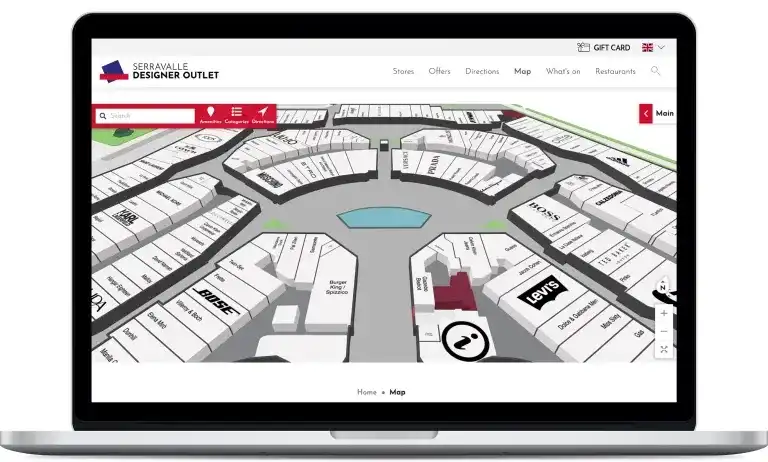A hospital asset tracking system provides healthcare employees and administrators with valuable information to streamline their operations and increase efficiencies. Paired with a digital indoor map, asset tracking and management is taken to the next level by creating new efficiencies and experiences.

Using asset tracking in hospitals & healthcare facilities
Asset tracking is the method of tracking physical assets, whether inventory, machinery, people, devices, or other medical items. Asset tracking provides building owners and operators with valuable information to streamline their business operations and increase efficiencies. Paired with a digital indoor map, asset tracking and management is taken to the next level by creating new efficiencies and experiences.
Hospitals and healthcare facilities have a vast quantity and wide variety of medical devices and assets that should be tracked in order to improve operations, minimize wasted time, and cut costs. Through the use of hospital asset tracking software, healthcare facilities can:
- Enable staff to quickly and easily locate medical equipment in real-time
- Reduce replacement costs of lost or stolen hospital equipment
- Track and review asset ROI
- Monitor asset utilization
- Ensure accurate performance data
- Improve inventory management and accuracy
- Create an efficient use of physical space and organized equipment storage
Why is hospital asset tracking so effective?
Monitoring the location and usage of assets in a hospital is so effective because this data can help drive new processes and reduce costs and if hospital employees were to track assets manually, the time it would take to collect this information would have a negative impact on operations. In fact, it’s estimated that nurses spend around 6,000 hours a month searching for medical equipment.
Installing a hospital asset tracking system can even improve patient care and the overall patient experience. It can also help to notify hospital staff when a piece of equipment is not returned to its correct location or is scheduled for regular maintenance, which helps to ensure assets remain compliant.

Why is medical asset tracking important?
Medical asset tracking is important because of the crucial and costly assets that are being tracked. These assets often include:
- Machinery
- Equipment
- Medication
- Medical waste
- IT hardware
- Patient documents
- Healthcare personnel
Benefits of using healthcare asset tracking software
Deploying asset tracking systems across healthcare venues has become essential in order to reduce costs and improve patient services. Benefits of this technology range from real-time location tracking and safety management, to environment monitoring, and beyond.
Improve inventory management
Asset tracking improves inventory management because employees and hospital administrators can quickly assess where hospital equipment is within the venue, understand equipment usage, and plan to purchase new equipment or supplies in advance of depreciation or expiry dates. Hospital asset tracking software can also provide detailed reports on medical inventory usage, costs, and more for medical staff.

Lower operational costs
Healthcare asset tracking systems allow nurses and other hospital employees to spend time caring for patients that would otherwise be spent looking for equipment and supplies. There is also huge cost savings in locating misplaced assets or missing equipment. Lost and stolen equipment costs the healthcare industry millions each year.
Automate clinical inventory
Automating hospital supply chains can offer greater visibility, more accurate forecasting, and a means to help reduce costs throughout the healthcare continuum. Automation can reduce the need for clinical workers to engage in non-patient work and can help administrators make better long-term planning decisions.
Challenges of tracking assets in healthcare facilities
While healthcare asset management is vital for streamlining healthcare operations, there are some challenges that asset managers face, including bandwidth to investigate, install, and monitor these systems. Network connectivity and security is another challenge because of the nature of hospital venues and the sensitivity of the data collected. It is important to work with an asset tracking provider that is familiar with the healthcare sector and has solutions to these and other challenges.
Deploying mobile asset tracking in a healthcare facility
Mobile asset tracking uses indoor positioning to understand an object’s real-time position as it moves through the healthcare facility. Fixed asset tracking, on the other hand, is more focused on an object’s ‘health’ - including its performance, utilization, lifecycle, and so on. Mobile, or real-time asset tracking might track assets such as hospital beds, personnel, or important documents that often move around. To implement an effective system, hospitals will need to look at indoor positioning, indoor mapping, and asset tracking software.

Why use Mappedin?
In order to have a successful asset tracking solution, businesses must understand where inventory, critical equipment, and so on are located within the context of the building. Indoor mapping works hand-in-hand with asset tracking as a way to visualize these various data points. To ensure the most accurate data is collected and displayed, digital hospital maps should be kept up-to-date as floor plans, layouts, and building structures change over time.
Mappedin is the leading provider of indoor maps and map management tools. Our powerful map editor is used by businesses spanning across a number of unique industries in order to create, edit, and maintain indoor floor plans over time. Mappedin Venue Format (MVF) is a geoJSON based format that provides customers with geometry and location data associated with their venue and is directly connected to the Mappedin CMS. MVF can be used to build 2D mapping experiences or converted with a variety of 3D renderers, including Mappedin’s.

Healthcare asset tracking FAQs
Can Iot help automate inventory management?
Internet of Things (IoT) displays a network of physical objects that are embedded with sensors, software, and other technologies. The purpose of IoT implementations is to connect each of these systems and exchange information, in some cases providing real-time tracking information. IoT devices are helping to improve inventory management by helping businesses easily keep track of the precise asset location. This helps reduce the time it takes to find inventory. All of the available real-time data helps provide valuable insights to support strategic and tactical business decisions.
How does hospital asset tracking Work?
A hospital asset tracking system provides healthcare employees and administrators with valuable information to streamline their operations and increase efficiencies. Paired with a digital indoor map, asset tracking and management is taken to the next level by creating new efficiencies and experiences.
What is the best way to monitor healthcare assets?
The best way to monitor healthcare assets is to implement an asset tracking system that utilizes indoor positioning and incorporate an accurate and digital floor plan map in order to visualize the movement and location of these assets within the building. Contact us to learn more.
Share


